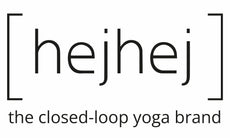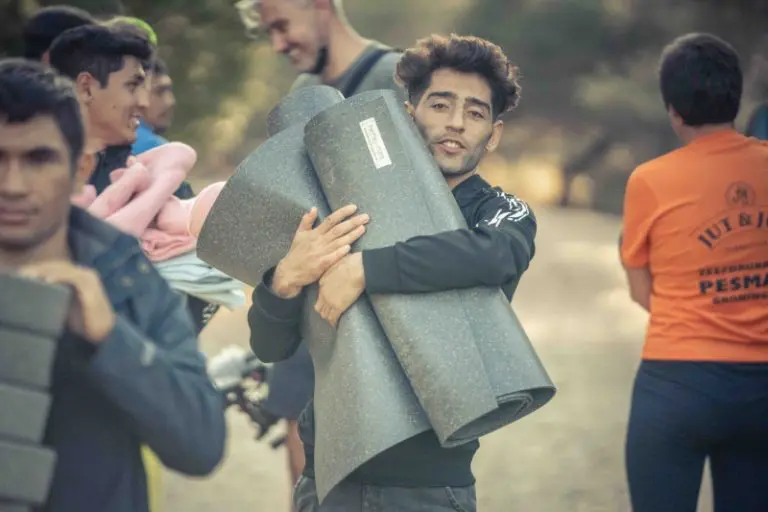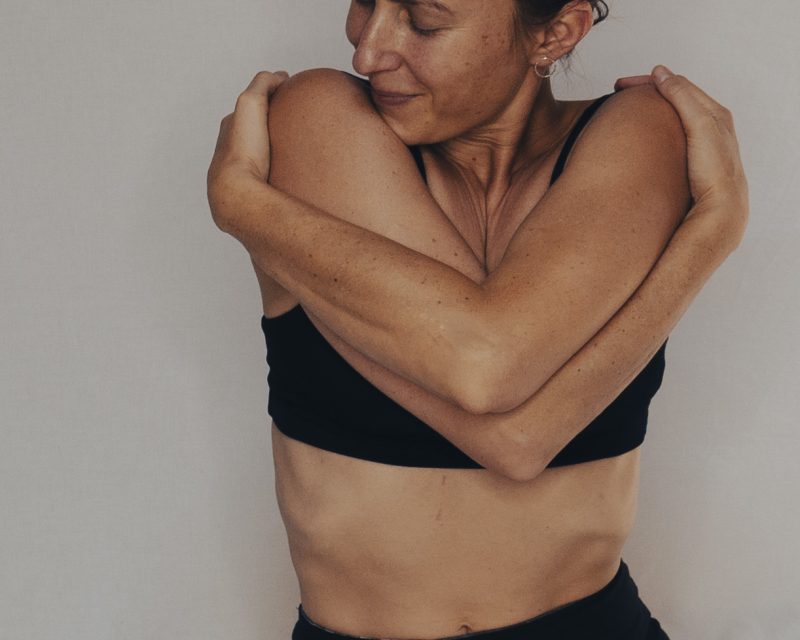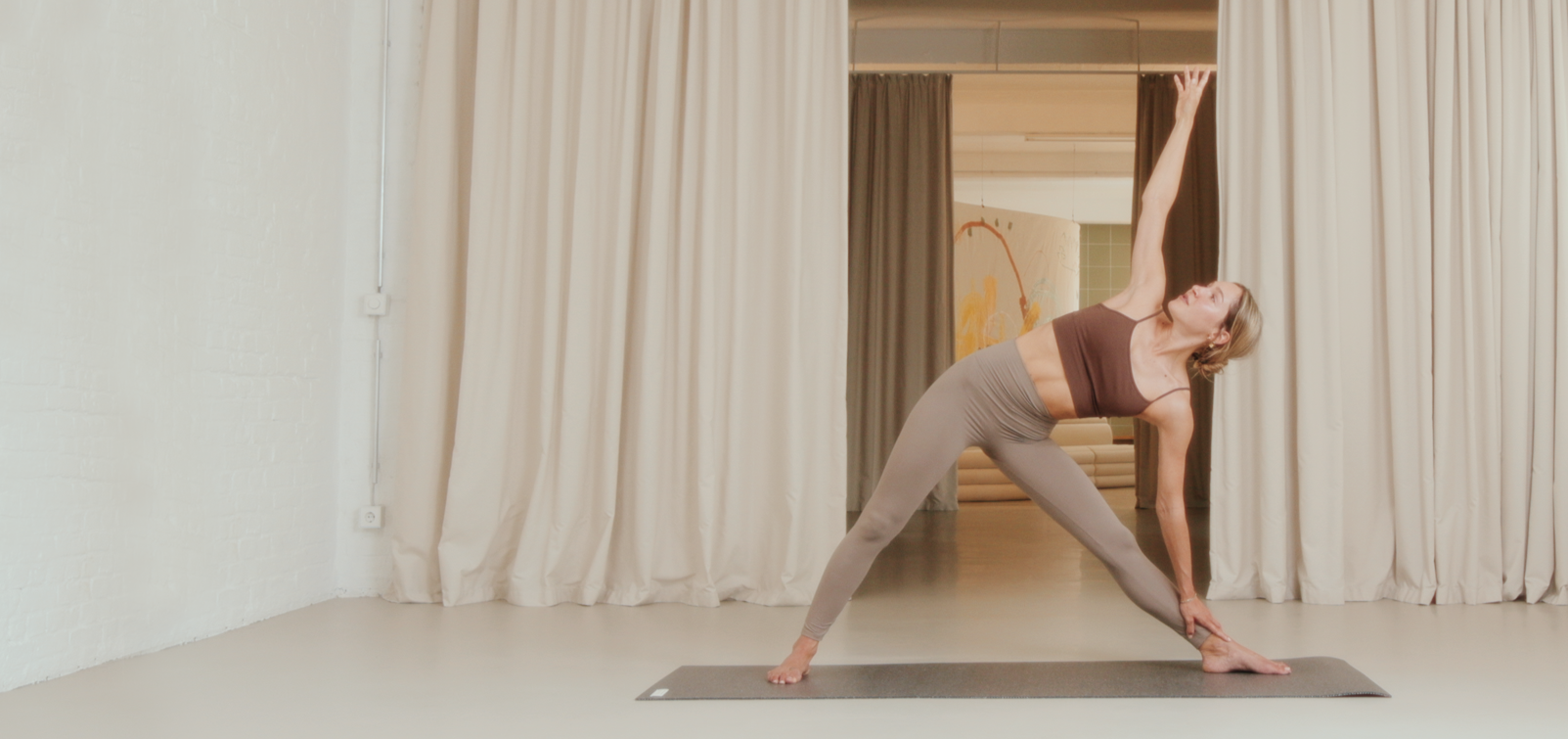The yoga block is probably the most widespread tool in the yoga world. At the beginning of your yoga journey, the block can support you to be well aligned in certain exercises and help you to slowly approach a yoga exercise. If you already have some experience, you can even intensify your asanas or learn new things with the yoga block!
In the following post we present our 5 favourite yoga block exercises with the sustainable hejhej yoga block.
We have already done a similar post for the hejhej-strap yoga belt and the hejhej-bolster yoga pillow – take a look.
hejhej-block – sustainable & minimalistic
The hejhej-block, a sustainable yoga block, is made from the same material as the hejhej-mat – leftovers from the foam industry. For this product, we have also committed ourselves to closed-loop production. This way, if the block has had its day, you can simply send it back to us free of charge and receive a discount code for your next purchase in our online shop. We then recycle it back to 100% and can use it to make new yoga blocks or yoga mats. The hejhej-block is 100% made in Germany and handmade.
As with the hejhej-mat, a wafer-thin layer of the hejhej-block that conforms to toy standards is not yet made of recycled materials. We have tested the hejhej yoga block according to EN 71 safety of toys. This layer ensures the guaranteed health of the hejhej-block and very high longevity. This layer is closed-pored, so no liquid penetrates the material, making the block durable and slip-resistant. The hejhej-block, just like the hejhej-mat, is also 100% recyclable in the end. We are constantly developing products to make this layer from recycled materials as well. Especially the slip resistance is something very special about this yoga block because you can rely 100% on it during your asana practice.
In workshops for people with disabilities, the yoga block is packaged 100% plastic-free and shipped to you. 0,50 € per hejhej-block will be donated to the NGO EarthChild Project. EarthChild Project gives children in Cape Town’s townships access to yoga and environmental studies.

Criteria we have focused on
In addition to the circular economy of production and the complete recycling of the end product, we have also paid attention to other criteria in order to develop a yoga block that is as sustainable as possible for you. The hejhej-block is deliberately somewhat larger and heavier than perhaps conventional yoga blocks. This is particularly important to us so that the block sticks as firmly as possible to the mat during your yoga practice and does not slip away or tip over. The hejhej-block promises you a safe asana practice in which you get particularly good stability. You can trust him completely. Despite the strength of the material, a certain softness is super important to us at the same time – yin and yang are balanced here too. So if you ever want to put your head or tailbone on the hejhej-block, it’s really comfortable. For this reason, the corners are also slightly rounded and the hejhej-block fits very smoothly in your hand.
The hejhej-block is in a matching design to the hejhej-mats.
Our favourite yoga block exercises with the sustainable hejhej-block
Below we present some selected yoga block exercises that are perfect to try with the hejhej-block. Place your yoga block(s) next to your yoga mat from the beginning so that you can easily reach them at any time.
1. Adhomukha shvanasana – the downward facing dog with yoga blocks
As already described with the yoga strap, the yoga block can also extend your arms or legs. It helps you bring the ground closer to you – thus contributing to grounding. The stretch can thus be consciously placed on the backs of the legs. Try to build up your downward facing dog once on both hejhej yoga blocks. Your hands have such a firm grip on the blocks. The closed-pored surface makes the yoga block super non-slip and you can press your hands deep into the floor.

2. Trikonasana – the triangle
Yoga equipment helps you to stand “correctly” in your asana. Come into a big lunge on your hejhej-mat to build up your triangle. Place the back foot parallel to the short edge of the mat, let the toes of the front foot point towards the short edge of the mat and bend this leg. Your knee is above the ankle and the yoga block is waiting on the inside of the foot. Your pelvic floor is tense, your belly button pulls inwards and your back is straight. Now lower your front hand onto the yoga block, your back still stretched. Now grasp your yoga block with the lower hand. Your upper arm pulls towards the sky. Your shoulders are stacked, the front of your body is open. By placing your hand on the yoga block, you can focus entirely on your upper body, feel length and freedom.

3. Bakasana – the crow
You can also practice this advanced yoga exercise once with your hejhej yoga block. Your fingers are spread wide and powerful on your yoga mat. Your abdomen is firm and your pelvic floor is tense. Your gaze is always on the mat in front of you in the crow, so you avoid falling forward. The yoga block offers you the perfect height to try out the balancing exercise. First place the ball of your foot on the block. When you feel properly aligned, with your knees on your upper arms, slowly move your weight onto your toes. This way you can get a feel for your balance. If you feel confident, you can now playfully shift your weight onto your toes. You can practise this until your weight and therefore your balance is only on your hands.

4. Variation of purvottanasana – plateau pose
This variation is also particularly suitable for postnatal yoga or even during your period if you don’t want to stimulate too much tension in your belly. Nevertheless, this yoga block exercise is full of strength and satisfaction. Get into the kneeling position. Your back is also very long and straight here, your belly hubs pulls inwards. Now stretch your right leg out in front of you, actively pointing your toes. Come into a backbend that feels good for you. Your right-hand grips your set-up yoga block underneath you. The force of your belly and your left outstretched arm pull you up and lengthen like a feather. With your hand on the hejhej-block, you can help yourself deeper into the backbend. To come out of the Asana, first, bring your left arm down and then slowly move your buttocks towards the yoga mat. Practice this variation of Purvottanasana to the other side as well.

5. Variation of the cobra with a yoga block
Get on your hejhej-mat in a prone position. The Cobra is a perfect backbend that can be built up to many different levels of difficulty. Place your yoga block at the base of your ribs. The edges of the hejhej yoga block are intentionally rounded so that this position should also feel comfortable for you. Your legs are active and pointed. Your big toes touch each other lightly. Now clasp your hands behind your buttocks and interlace your fingers. Your abdominal muscles hold you up, your yoga block supports. Your head is relaxed and aligned with your upper body. Relax your neck. A smile is on your face. Did you know that smiling automatically tenses the inner abdominal muscles?
First, release your arms, place your hands on the mat, push your buttocks towards your heels, lower your upper body onto your thighs. In the child’s pose, you can reflect on this exercise very well.
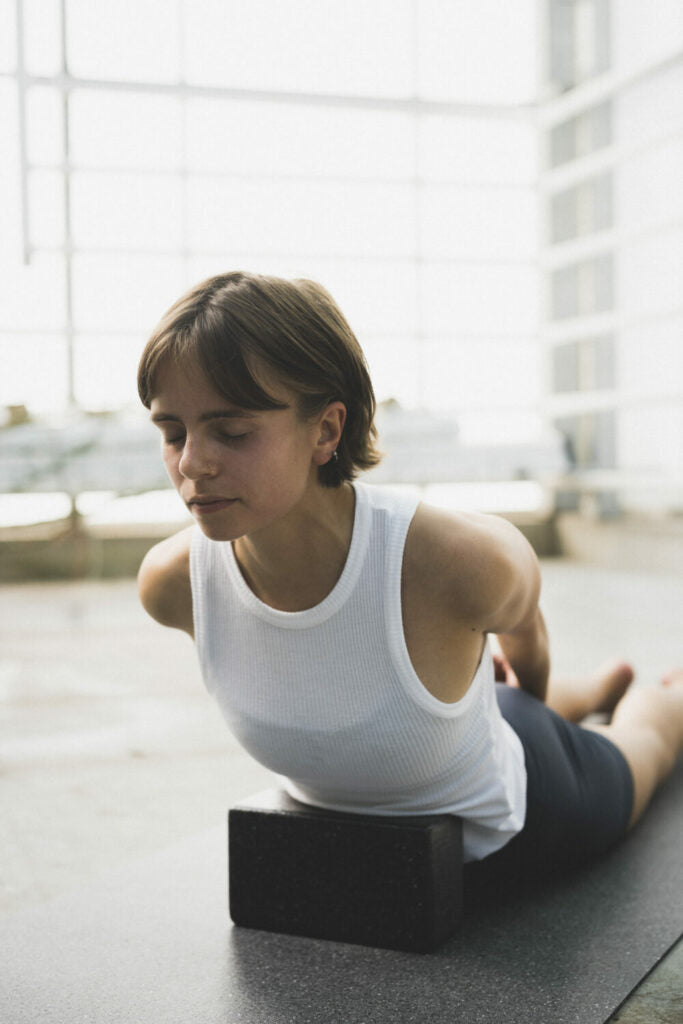
Equipment in yoga is a great way to perform already known exercises in a different way. This allows you to change your focus and you can powerfully and calmly direct your attention to other areas in your body. On our Youtube channel we also have some yoga flows for you, in which the hejhej-block is wonderfully integrated. Yoga flow with blocks – 30 min yoga block workout (English), Katonah Yoga Basics active Class | 30 min (English) or Power Yoga and Meditation | 20 min (German). Have fun actively practising with the yoga block.
We hope you enjoy discovering your hejhej yoga block!
